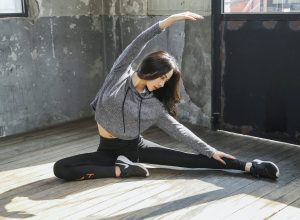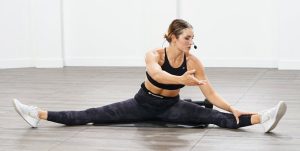Stretch and Recover 10 Stretches for the Hips That Can Benefit Everybody

Best Given that so many of Stretch and Recover us spend most of the day sitting in the car, at a desk, or on the couch—it’s no wonder feeling “tight” in the hips is a common complaint.
“I hear people complain about tightness in their hips during every single [personal training] session,” said Lauren Kanski, NASM-CPT, a certified personal trainer and coach in New York City. “Multiple times, every single day, it’s the most common area people ask for help on besides their lower back.”
Spending a big chunk of the day in a seated position means your hips hold a flexed (or shortened) position all day, making moving afterward—even just standing up—feel tough. Stretching out your hip muscles and moving regularly throughout the day can help ease stiff hips and ward off hip pain and injury.
The Importance of Hip Stretching
Even if you don’t feel tight, it’s essential to tend to your hips, especially if you feel stressed. “We store a lot of stress and emotions in our hips,” Kanski explained. “We transfer energy between the upper part of the body and the lower part of the body to function and move, and the hips are the primary transfer point of that energy.” Opening the hips can alleviate some tension and perk up your energy levels.
Stretching your hips consistently could potentially reap several other benefits, including:
Konrad A, Močnik R, Titze S, Nakamura M, Tilp M. Int J Environ Res Public Health. 2021;18(4):1936. doi:10.3390/ijerph18041936
Less tightness in the hip flexors
Reduced pain in the lower back
Increased range of movement in your hips
Less injury
Better performance
When To Stretch Your Hips
Stretch and Recover Stretch and RecoverTo keep your hips healthy, show them some TLC every day. Kanski suggested stretching them out after you wake up in the morning, before your workouts, and before you head to bed, ideally. But even more important is stretching your hips before and after a workout.
Keep stretches active or dynamic when warming up before your workout—that means only holding for a few seconds and moving in and out of the pose.
Go for passive or static stretches to cool down after a sweat, holding each position for about 30 seconds.
Stretch and Recover The stretches below, shared by Kanski, are a mixture of both—one through eight are dynamic stretches to keep things moving, while stretches nine through 15 are meant for when you finally slow things down.
- Adductor Rock Back
How to Use the Adductor Rock Back Exercise for Rehabilitation Purposes
Stretch and Recover The Adductor Rock Back exercise is not only beneficial for athletes and fitness enthusiasts but also serves as a valuable tool for rehabilitation purposes. It can be used to address various hip-related conditions and imbalances. In this article, we will explore how the Adductor Rock Back exercise can be utilized in a rehabilitation setting, focusing on its application for specific conditions and injuries.
Hip impingement syndrome:Stretch and Recover Individuals with hip impingement syndrome often experience pain and limited range of motion in the hip joint. The Adductor Rock Back exercise can help address this condition by stretching and strengthening the adductors, improving hip stability, and promoting proper alignment and movement of the hip joint.
Groin strains: Groin strains are common injuries among athletes, particularly those involved in sports with sudden changes in direction or kicking motions. The Adductor Rock Back exercise can be used during. It will be better for Back & Hips pain.
2. Walking Lateral Lunges
Stretch and RecoverWalking lateral lunges are a dynamic exercise that targets the lower body, particularly the glutes, quads, and adductor muscles. This exercise not only strengthens and tones these muscle groups but also enhances hip mobility and improves overall lower body stability. In this article, we will explore the benefits, proper technique, and variations of walking lateral lunges.
To perform walking lateral lunges, follow these steps:
- Begin by standing with your feet hip-width apart and your hands resting on your hips or extended in front of you for balance.
- Take a wide step to the side with your right foot, keeping your toes pointed forward.
- As you step to the side, shift your body weight to the right, bending your right knee and lowering your body into a lunge position. Your right thigh should be parallel to the ground, and your knee should be aligned with your toes.
- Push off with your right foot and bring your left foot to meet the right foot, returning to a standing position.
- Repeat the movement, this time stepping to the left side and lunging with your left leg.
For More Information Click Here
The Benefits of Stretching

Stretching is like a soothing symphony for your muscles and joints. It’s not just for athletes; it’s for everyone seeking to enhance their overall well-being.
Increased Flexibility:
Regular stretching helps improve your range of motion, making it easier to perform everyday activities with ease and comfort.
Reduced Muscle Tension:
Stretching relaxes your muscles, releasing built-up tension that can lead to discomfort and pain.
Improved Blood Circulation:
As you stretch, blood flow to your muscles increases, delivering essential nutrients and oxygen for optimal function.
Enhanced Posture:
Stretching helps align your muscles and joints, contributing to better posture and reducing the risk of musculoskeletal issues.
Incorporating Stretching into Your Routine
Morning Wake-Up Stretch:
Stretch and Recover Start your day with gentle stretches to awaken your body. Reach for the sky with your arms, do some side stretches, and rotate your ankles and wrists.
Office or Desk Stretches:
Pre-Exercise Warm-Up:
Post-Exercise Cool Down:
Wind down after a workout with static stretches. Focus on the major muscle groups you engaged, holding each stretch for 15-30 seconds.
Evening Relaxation Stretch:

Stretch and Recover Before bed, indulge in some calming stretches to help release any tension from the day. Gentle yoga poses like Child’s Pose or Legs Up the Wall are wonderful options.
The Importance of Recovery
Recovery is like a reset button for your body. It’s the time when your muscles repair, rebuild, and grow stronger. Prioritizing recovery ensures that your body can perform at its best.
Muscle Repair and Growth:
During recovery, your body repairs microscopic muscle fibers that have been stressed during exercise, making them stronger and more resilient.
Reduction of Inflammation:
Adequate rest and recovery time help reduce inflammation in your muscles and joints, which can lead to pain and discomfort.
Prevention of Overuse Injuries:
Stretch and Recover Giving your body the time it needs to recover helps prevent overuse injuries that can occur when you push yourself too hard without sufficient rest.
Improved Performance:
Stretch and Recover Proper recovery leads to better performance in your workouts or physical activities. It allows you to give your all during exercise, leading to more significant gains.
Incorporating Recovery Techniques
Quality Sleep:
Aim for 7-9 hours of restorative sleep each night. This is when your body does most of its repair and regeneration.
Hydration and Nutrition:
Stretch and Recover Stay well-hydrated and provide your body with the nutrients it needs for recovery. Include a balance of carbohydrates, proteins, healthy fats, vitamins, and minerals in your diet.
Foam Rolling and Self-Massage:
Use a foam roller or massage tools to release knots and tension in your muscles. This aids in improving blood flow and reducing soreness.
Active Recovery Days:
Stretch and Recover On rest days, engage in low-intensity activities like walking, yoga, or gentle stretching to keep your body moving without adding stress.
Mindfulness and Relaxation Techniques:
Practices like deep breathing, meditation, and mindfulness help calm your nervous system and promote mental and emotional well-being.
Listening to Your Body
Stretch and Recover The key to effective stretching and recovery is listening to your body. It will tell you what it needs. If a stretch feels uncomfortable or painful, back off a bit.
Stretch and Recover If you’re feeling fatigued or sore, give your body the rest it deserves. Pay attention to the signals it’s sending you.
Conclusion:
Nurturing Your Body, Nurturing Your Soul Stretching and recovery are not just physical practices; they’re acts of self-love.
They’re about honoring and cherishing the vessel that carries you through life. By incorporating these simple yet powerful techniques into your daily routine, you’re not only promoting physical health but also nurturing your mental and emotional well-being.
So, remember to stretch, recover, and give your body the care it deserves. Your body will thank you with vitality, strength, and a deep sense of well-being.


Hi, this is a comment.
To get started with moderating, editing, and deleting comments, please visit the Comments screen in the dashboard.
Commenter avatars come from Gravatar.